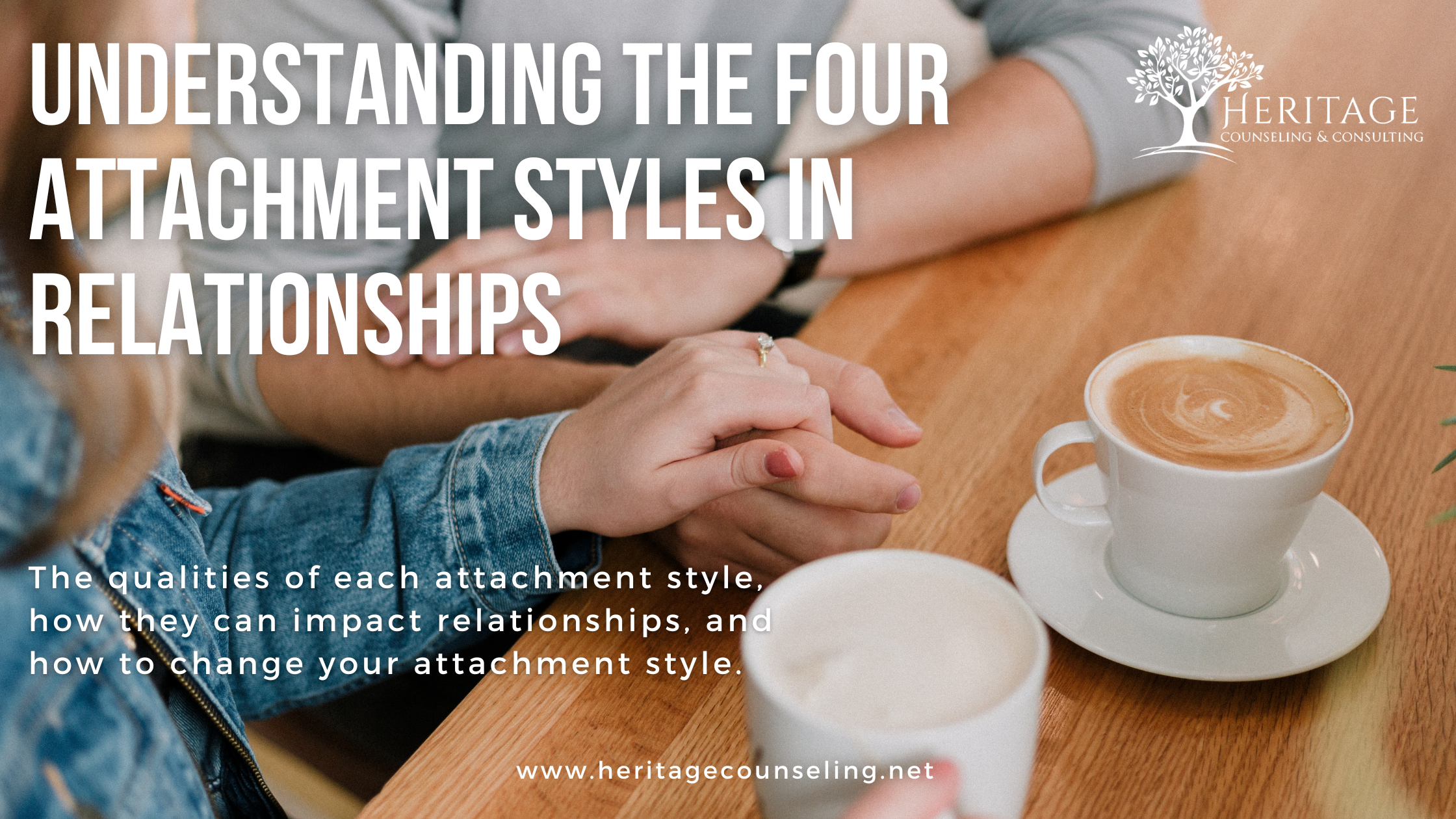What is attachment? Attachment is how we view security, comfort, separation, and sharing space with others. Many times it is easy for individuals to feel a certain way in relationships, yet remaining unaware of why one may struggle to connect with some and others they feel comfortable to be themselves. When we are young, we form attachments to those who raise us, if those attachments are insecure, we may see these factors impact the ways in which we develop and grow through how we try to connect with others. Attachment styles develop early in our lives and are shaped by our upbringing. Although it is shaped by upbringing; this does not mean it can not form attachments that appear more secure. Attachment styles are broken down into four main categories: Anxious attachment, Avoidance attachment, Disorganized attachment, and Secure attachment. Attachment styles impact all relationships, such as professional, romantic, and social, and when an individual can form secure attachments with others, they will see an improvement in their emotional well-being. *******
Anxious Attachment
Characteristics of anxious attachment
Fear of abandonment
Overdependence on a partner
Negative Self-view
Feeling unworthy of love
Hypervigilent of threat
Doubt and uncertainty of their partner's investment
Anxious attachment can be seen as someone who has a negative or diminished view of themselves, yet will view others in a bright light, continuing to look down on themselves as they lift others up in their eyes. This can be caused by one’s caregiver being present but not fully aware of what the child needs or wants. Anxious attachment can be formed when a caregiver is supportive but not in sync with the child. This may leave the child feeling confused and uncertain in their relationship with their caregiver.
Some effective coping strategies that one with anxious attachment can benefit from are proper communication, working to identify emotions and needs, and attending consistent therapy sessions. In this, the individual can calmly and safely express how they are feeling as the partner learns how to be present for them without causing triggers. Adding in an activity called “rituals of attachment”, where the partners agree to make a conscious effort to acknowledge one is leaving but they will return, can form secure healing. Some challenges that could be faced are the partner not fully understanding why their partner is acting the way they are and in this not providing the safe responses needed to ground them and bringing them back to center in the moment. *, **
Avoidant Attachment
Characteristics of avoidant attachment
Fear of intimacy and closeness
Emotional distance
Overly self-sufficient
Eager to gain support/Approval
Avoidant attachment can also be called dismissive or anxious-avoidant attachment. Avoidant attachment is seen to form when one’s caregiver is present but does not provide the proper support one needs. Although the caregiver may wash and feed the child, they will not soothe or nurture them, leading them to divert from situations that may cause them to show emotions or intimacy with others. The child may have never been shown or encouraged to express their emotions and needs. Caregivers have taught these people to fend for themselves which has led them to create a mindset believing that they do not need others or a relationship to feel fulfilled.
When it comes to coping with avoidant attachment one of the most important things to do is regulate one’s emotions. If an individual can self-regulate as well as prepare for possibly triggering situations, they can remain calm and present in the moment instead of diverting and running when they feel triggered or unstable. Coping with the behaviors of avoidant attachment can be an extremely challenging task because one has to ignore and unlearn all of the learned behavior they have known since being a young child. Some of the top ways to rewrite one’s path of avoidant attachment is to, challenge oneself to show emotions when they do not want to as well as allow oneself to trust and depend on others. **
Disorganized Attachment
Characteristics of disorganized attachment
Conflicting emotions and behaviors
Unresolved trauma
Relationships seen as desire and fear
Struggle with Identity
Struggle regulating emotions
Can act irrationally in relationships
Avoidant Behaviors
Disorganized attachment can be seen as one switching from anxious attachment to avoidant attachment. This form of attachment is one that is seen the least but can be formed through childhood trauma or continuous fear. This can form when one has little to no connection with their caregiver, meaning that their caregiver was distant or not around when growing up. This can be seen to develop into possible personality disorders in which the individual does not trust or desire to form relationships with others and lives in a state of panic, distrust, or fear. Disorganized attachment styles are seen to form through neglect and abuse. These are individuals who were forced to raise themselves, although they may feel that disorganized attachment is their identity, this attachment style does not define them and they have to ability to form secure attachments with others through therapy work and breaking down barriers.
People with a disorganized attachment style can benefit from dialectical behavior therapy (DBT), which is seen to be most helpful for those who have intense emotions. Emotions can be high for some and catastrophic for others, and one of the best strategies, when one has a disorganized attachment, is to pursue counseling one-on-one to process and work through their childhood as well as understand who they are outside of the attachment style. Some coping strategies that have been seen to be the most effective with this attachment style are identity work, rewriting intrusive thoughts and emotions, and trust exercises where they learn to see and trust others. ***
Secure Attachment
Characteristics of secure attachment
Comfort with intimacy and independence
Trust and emotional balance
Base relationships on honesty
Form positive views of themselves
Effective communication
High self-esteem
Self-reflecting with others
Open to receiving emotional support
Secure attachment is the most sought-after attachment style due to it being one where the individual feels strong and confident not only in themself but in those they choose to form connections with. Those with this attachment style had caregivers who were present, supportive, and nurturing, and provided an environment in which they felt safe. Emotions were welcomed and openly spoken about creating an emotionally secure environment for the individual and the caregiver.
Although one may have a secure attachment it is important for them to nurture this attachment in relationships to remain secure. In order to nurture the attachment it is important to remain aware of one’s emotions and how they are impacting themselves and others. Being open and honest in relationships is key to feeling secure and safe. Although those with secure attachment may feel independent, it is important to not let that independence overrun relationships, meaning it is healthy to allow others in and to ask for help. ****
Impact on Relationships
Attachment styles have a massive impact on romantic relationships in the ways in which an individual is willing to trust and feel safe. For example, someone with an anxious attachment style may be hyperaware of their partner's needs, and willing to do anything for them. Someone with Avoidant attachment may flee from emotions in relationships and become attached and physical intimacy may be all they crave due to feeling that emotional connections are unheard of. Those with disorganized attachment may crave love and security but on the same hand will run from it because intimacy and vulnerability can be terrifying and confusing. Partners yearn for their partner to have secure attachment in that, they long for safety, love, and connection.
If partners have different attachment styles that conflict, it does not mean they are not meant to be, but that with work, communication, and emotional regulation attachment barriers can be broken. Healthy relationship dynamics are crucial to a strong connection in a relationship and some ways in which these can be improved are, having healthy relationship boundaries, open communication on expectations, as well as building emotional and physical trust. *****
Changing Attachment Styles
It is a common belief that once an attachment style is formed, it can not be changed. However; according to years of research and observation all attachment styles can be changed. This can be done with hard work, consistent counseling, emotional regulation, and the willingness to face one’s past and sit in the discomfort of change.
Therapy is one of the most valuable tools when it comes to transforming attachment styles through psychoeducation on each attachment style, to the realization of your own attachment style, to conquering what it may look like to feel and represent secure attachment. Counseling can be a large step but with the right guidance and support, one does not have to live in the attachment style they were shown from a young age.
It is easy for us as humans to look at others' attachment styles; however, one of the greatest challenges is accepting our own attachment style due to having to sit in the discomfort that it was influenced by our caregivers and our upbringing. When one takes a step into self-awareness and personal growth the process of transformation is truly one of the most remarkable experiences. ******
Conclusion
Attachment styles have the ability to control our relationships, professional life, and day-to-day activities. Once we are given the tools to recognize and see the attachment style that is running our life in comparison to another form of attachment, individuals are given a gift that allows them to transform their life and take a stand on something that may feel as if it was pre-written for them.
Relationships and connection are massively important to the growth of individuals and when individuals are self-aware regarding their willingness or lack of willingness to connect and share with others, changes can be made and healthy relationships can be fostered.
Secure connections provide the gift of allowing one to feel whole and seen. When one takes the steps to sit temporarily in the discomfort as they work toward secure, fulfilling connections they are not allowing transforming their life but the generations to come and the legacy they will leave behind.
If you or someone you know is looking for professional help with understanding and improving attachment styles in relationships, please give Heritage Counseling & Consulting a call at 214-363-2345 to get more information and schedule an appointment.
Sources:
*https://www.attachmentproject.com/blog/four-attachment-styles/
** https://health.clevelandclinic.org/attachment-theory-and-attachment-styles/
****http://myweb.sabanciuniv.edu/emreselcuk/files/2019/09/GillathSelcukShaver08.pdf
*******https://dictionary.apa.org/attachment-and-biobehavioral-catch-up-intervention

